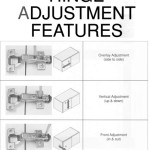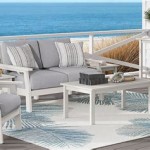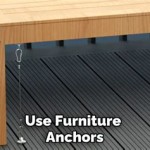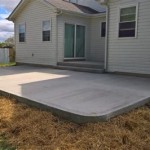Patio With Built-In Seating: A Comprehensive Guide
Patio design is an important consideration for homeowners seeking to extend their living space to the outdoors. A well-designed patio can serve as a place for relaxation, entertainment, and connection with nature. One of the most effective ways to maximize both the functionality and aesthetic appeal of a patio is to incorporate built-in seating. Built-in seating offers several advantages over freestanding furniture, including space efficiency, durability, and the opportunity to create a cohesive and integrated design. This article will explore various aspects of patios with built-in seating, covering design considerations, material selection, construction methods, and maintenance tips.
Key Point 1: Design Considerations for Built-In Patio Seating
Planning is paramount when incorporating built-in seating into a patio design. Several factors must be considered to ensure that the seating complements the overall space and meets the needs of the users. These include the layout of the patio, the available space, the desired seating capacity, the style of the home, and the functionality of the seating area.
Layout and Space: The layout of the patio dictates the optimal placement and configuration of the built-in seating. Consider the flow of traffic on the patio and ensure that the seating does not obstruct pathways or create bottlenecks. Measure the available space accurately to determine the maximum dimensions of the seating area. A small patio might benefit from a corner bench, while a larger space could accommodate a U-shaped seating arrangement or a series of individual benches.
Seating Capacity: Determine the number of people the seating area needs to accommodate regularly. This will influence the length and depth of the benches or walls. For occasional larger gatherings, consider incorporating additional portable seating options that can be easily added or removed as needed.
Architectural Style: The style of the built-in seating should complement the architectural style of the home and the existing patio. A modern home might call for sleek, minimalist seating with clean lines, while a rustic home could benefit from seating constructed from natural stone or reclaimed wood. Consider the color palette of the home and the patio, and choose materials and finishes that harmonize with the existing aesthetic.
Functionality: Consider how the seating area will be used. Will it be primarily for dining, relaxation, or entertaining? This will influence the design of the seating. For dining, ensure that the seating is at a comfortable height for the table. For relaxation, consider incorporating backrests or cushions for added comfort. For entertaining, think about incorporating features such as built-in storage, lighting, or even a fire pit.
Ergonomics: Ergonomics are crucial for comfortable seating. Consider the height, depth, and angle of the seat. A seat height of 16-18 inches is generally comfortable for most people. A seat depth of 18-20 inches provides ample space for sitting. A slight backrest angle can improve comfort and support. Incorporating cushions and pillows can further enhance the ergonomic design.
Sun and Shade: Evaluate the sun exposure on the patio. If the seating area is exposed to direct sunlight for extended periods, consider incorporating shade structures such as pergolas, umbrellas, or trees. This will provide a more comfortable and usable seating area, especially during hot summer months. Orient the seating to take advantage of prevailing breezes and avoid facing directly into the setting sun.
Key Point 2: Material Selection and Construction Methods
The choice of materials is critical for the durability, appearance, and overall success of built-in patio seating. The materials must be weather-resistant, low-maintenance, and aesthetically pleasing. Common materials include wood, stone, brick, concrete, and composites. Each material has its own advantages and disadvantages, and the best choice will depend on the design, budget, and climate.
Wood: Wood is a classic choice for patio seating, offering warmth and natural beauty. Redwood, cedar, and teak are popular choices due to their natural resistance to decay and insects. However, wood requires regular maintenance, such as staining or sealing, to protect it from the elements. Pressure-treated lumber can also be used, but it may not have the same aesthetic appeal as natural wood. When using wood, ensure it is properly seasoned and treated to prevent warping and cracking.
Stone: Stone is a durable and low-maintenance option for built-in seating. Natural stone, such as flagstone, limestone, or granite, can create a rustic and elegant look. Stone is resistant to weather and insects and requires minimal maintenance. However, stone can be more expensive than other materials, and it can be heavy and difficult to work with. Consider the texture and color of the stone to ensure that it complements the overall design of the patio.
Brick: Brick is another durable and visually appealing option. It offers a classic, timeless look and is relatively easy to install. Brick is resistant to weather and insects and requires minimal maintenance. However, brick can be porous and may absorb moisture, which can lead to cracking in cold climates. Sealing the brick can help to prevent moisture damage. Brick also offers a range of color and pattern options to suit various design styles.
Concrete: Concrete is a versatile and affordable material for built-in seating. It can be poured into a variety of shapes and sizes, and it can be stained or stamped to create different textures and patterns. Concrete is durable and low-maintenance, but it can be prone to cracking, especially in cold climates. Proper reinforcement and sealing can help to prevent cracking. Pre-cast concrete blocks or pavers are a convenient option for constructing walls or benches.
Composites: Composite materials, such as composite decking or siding, are becoming increasingly popular for outdoor seating. These materials are made from a combination of wood fibers and plastic, making them resistant to decay, insects, and moisture. Composites require minimal maintenance and are available in a variety of colors and styles. However, composites can be more expensive than wood, and they may not have the same natural look and feel.
Construction Methods: The construction method will depend on the materials used and the design of the seating. For wood seating, a sturdy frame is essential to support the weight of the users. Use high-quality screws or bolts to fasten the frame together. For stone or brick seating, a solid foundation is necessary to prevent settling and cracking. A concrete footing can provide a stable base for the seating. Ensure that the seating is properly level and that the surfaces are smooth and comfortable.
Key Point 3: Maintenance and Care of Built-In Patio Seating
Proper maintenance is crucial for prolonging the lifespan and maintaining the appearance of built-in patio seating. The specific maintenance requirements will depend on the materials used, but some general guidelines apply to all types of seating.
Cleaning: Regular cleaning is essential for removing dirt, debris, and stains. Sweep or vacuum the seating regularly to remove loose dirt and debris. Wash the seating with soap and water to remove stubborn stains. Use a mild detergent and a soft brush to avoid damaging the surface. For wood seating, use a wood cleaner specifically designed for outdoor use. For stone or brick seating, use a pressure washer with a low-pressure setting to remove dirt and grime. Avoid using harsh chemicals or abrasive cleaners, as these can damage the materials.
Sealing and Staining: Wood seating should be sealed or stained regularly to protect it from the elements. Apply a high-quality exterior sealant or stain every one to two years, depending on the climate and the type of wood. Before applying the sealant or stain, clean the wood thoroughly and allow it to dry completely. Follow the manufacturer's instructions for application. Stone or brick seating can also be sealed to prevent moisture absorption and staining. Use a penetrating sealant specifically designed for stone or brick. Apply the sealant according to the manufacturer's instructions.
Repairing Cracks and Damage: Inspect the seating regularly for cracks, chips, or other signs of damage. Repair any damage promptly to prevent it from spreading. For wood seating, fill cracks with wood filler and sand smooth before sealing or staining. For stone or brick seating, repair cracks with mortar or grout. Replace any damaged stones or bricks as needed. For concrete seating, repair cracks with concrete patching compound. Follow the manufacturer's instructions for application.
Protecting from the Elements: Protect the seating from the elements during the off-season. Cover the seating with a waterproof tarp or store it in a shed or garage. This will help to prevent damage from rain, snow, and ice. For wood seating, consider applying a coat of preservative before storing it. Remove any cushions or pillows and store them in a dry place. Regularly check the seating for signs of mold or mildew and clean it as needed.
Cushion Care: If the built-in seating incorporates cushions, proper care is essential to prolong their lifespan. Choose cushions made from weather-resistant materials such as outdoor fabrics. Clean the cushions regularly with soap and water. Remove any stains promptly. Store the cushions in a dry place during the off-season. Consider using cushion covers to protect them from the elements.
By carefully considering the design, materials, construction, and maintenance, homeowners can create beautiful and functional built-in patio seating that will enhance their outdoor living space for years to come.

9 Brilliant Built In Garden Benches Houzz Ie

Built In Patio Seating Landscaping Network

Built In Seating For A Pergola Struxure Denver 303 529 7819

Built In Bench Seating Modern Patio San Diego By Eco Minded Solutions Houzz

Outdoor Relaxation With Brick Seating And Benches Fulton Bricks Paving Supplies

Spring Patio Fix Ups 10 Wonderful Ways With Built In Benches

Deck Bench Design Ideas For Relaxing Outdoors

Outdoor L Shaped Dining Bench With Zinc Top Table Transitional Deck Patio

Fire Pit Design Tips Trends Outdoor Living By Belgard

Extended Paver Patio Grill Island Deck Retaining Wall Stone Steps Fire Pit A Plus Landscaping








